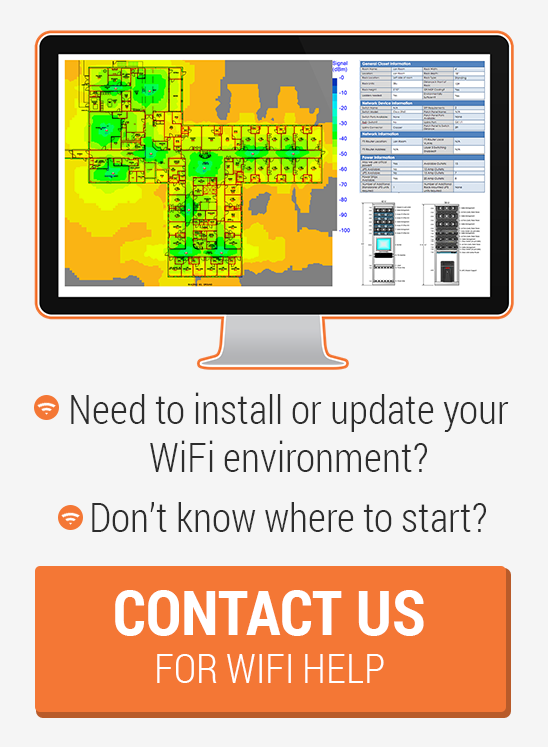Is Wireless Site Survey Worth It For My Business? How Much Does it cost?
“Measure twice, cut once,” is a famous proverb. Obviously it is a great rule for a carpenter. Cut the wood improperly and the piece is ruined. It’s more cost effective and faster to double-check the requirements before taking action.
As a network manager or business owner, this rule of thumb comes in handy when installing or upgrading a wireless network.
Measuring twice means making sure you have thought of all the things that could impact your wireless network before installation. It means making sure you have also thought of all of the business and budget requirements: locations that need WiFi, client devices or use cases for WiFi, interfering neighbor wireless networks, cost of labor to install equipment, cost of electronics (access points, switches, servers/management systems), cost to operate the network (yearly license fees, employee training).
There is philosophy that having a high percentage of information, say 60% or 70%, is enough to make a decision. This is true for strategic decisions, where you will never have a clear and complete picture, and action is required. But for implementing important information technology systems having a more complete picture is vital.
A wireless site survey provides this full picture and allows for double-checking of potential issues prior to implementation. With measure twice, cut once you understand your situation, put together your plan… and before you implement… make sure nothing has changed since you put together your original assumptions.
What are the different types of Wireless Site Surveys?
There are basically three types of wireless site surveys: passive, active and predictive.
In a passive wireless site survey specialized software is used to measure access points signal strength, and potential interference. In passive surveys, the listening WiFi adapters do not need to associate to the access point. They just passively listen and give a picture of the RF characteristics of wireless network sites. Passive surveys are often performed when upgrading existing wireless networks such as adding additional access points to fill dead zones.
During an active wireless site survey, a computer's wireless adapter is associated with an access point. This allows the gathering of detailed information about a network, such as coverage signal strength, throughput, and data rates. An active site survey is often performed in conjunction with a passive site survey at start of a new wireless network deployment or after the implementation to validate proper coverage and performance.
To perform a predictive wireless site survey, RF planning software tools are used to model wireless coverage of the access points based on floor plans and construction materials. A floor plan drawing of the site or building should be available in order to complete this type of survey. Predictive site surveys are used when the site or building is not yet built and are helpful for budgeting purposes. Predictive site surveys are also used to provide a rough estimate on the scope of work for planning future active or passive surveys.
All wireless site surveys aim to provide detailed information that addresses potential sources of interference, ideal access point placement, power requirements, and cabling specifications. You need this information before implementing or attempting to optimize a wireless network, so you can properly budget for the cost of all requirements - labor, materials, and other direct costs (ODC).
How Much Do Wireless Site Surveys Cost?
The cost of a wireless site survey depends on the type of survey performed.
Out of the list above the least expensive is a predictive wireless site survey - This type of survey uses computer modeling to "predict" the signal coverage and access point locations. The accuracy of this type of survey is impacted by the operator of the designing software and amount of information they have about planned installation location (floor plans, wall material types, use cases, device types, ceiling height, etc.).
A passive wireless site survey site tends to be more costly but can provide the most realistic information about potential issues in planned installation location. With the cost of enterprise access points starting at above $1200 on average for 802.11ac / 802.11ax hardware and licenses, going onsite and properly measuring signal, having first hand knowledge of the environment, is a prudent investment.
The cost of each type of survey depends on the size of the area, type of environment (carpeted office space, warehouse, educational, medical, outdoor, etc), use case (office Internet, device tracking, VoIP/video realtime communication, etc).
A good rule of thumb is that an experienced engineer can perform a predictive wireless site survey/design for a 50,0000 square feet area in a day and generate a detailed report with heat maps, access point locations, cabling requirements, switch requirements. A predictive wireless survey is usually performed using floor plans and an interview only in some cases engineers visit the site but they rarely walk the entire building or all areas. This limited view of all areas and potential issues tends to results in a design that is about 60%-70% accurate and most likely will requirement more post implementation adjustments such as add/move of access points to reach final 100% design.
The same area would require an about three days for a passive wireless survey and detailed report generation. For a passive site survey the engineer's report can go beyond information available in a predictive survey report. In many cases, engineers include photos of planned install locations, photos of mounting methodology (wall, ceiling, floor), photos of data closets and available rack space, photos available switch ports and POE budget for planned access points. Because a passive wireless site survey is performed on site the opportunity to inspect all areas related to the planned design is much easier and the design tends to be very close to 100% accurate and can be relied on by the install team for cabling and equipment installation.
Using your local market rate for consultants you can probably come up with the cost for these two scenarios. Remember that WiFi consultants are specialized engineers and are most likely using specialized and expensive software and tools that need to be considered when determining their hourly or daily rate. Also, take into consideration that the passive design requires the engineers to visit the location and may have associated travel costs and per diems.


